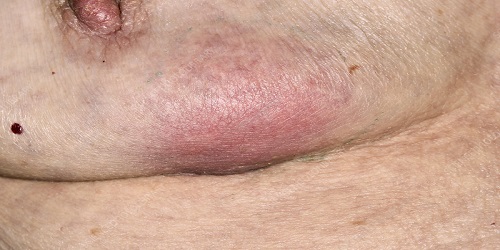Breast Abscess
What Is a Breast Abscess?
A breast abscess is a painful infection caused by bacteria. The most common type of bacteria that causes breast infections is Staphylococcus aureus.
Bacteria can enter through cracks in the skin of the breast or on the nipple.
The infection can invade the fatty tissue of the breast, causing swelling and pressure on the milk ducts.
This causes a hollow space to appear in the breast that contains pus.
Breast infections can affect all women but are most common in women who are breastfeeding.
In breastfeeding women, abscesses can be treated with antibiotics, but usually require surgical drainage. Your doctor may advise you to stop breastfeeding temporarily if you have an abscess.
Breast Abscess Symptoms
If a person experiences this, they may feel or see a mass in the breast tissue along with symptoms of infection.
These symptoms may include:
1. Low breast milk production.
2. Warmth in the breast area.
3. Pain in the breast.
4. Discharge from the nipple.
5. Red skin.
6. Fever.
7. Headache.
8. Nauseous.
9. Vomiting.
10. Flu-like symptoms.
11. Fatigue.
Causes of Breast Abscess
The cause of this condition is a bacterial infection, usually Staphylococcus aureus. The bacteria enter through a scratch on the skin or a tear in the nipple.
The resulting infection, called mastitis, invades the fatty tissue of the breast and causes swelling and pressure on the milk ducts. Abscesses can develop with severe mastitis.
Breast Abscess Risk Factors
A number of factors can increase the risk of developing this condition. However, not everyone with these risk factors will experience it.
Risk factors for breast abscess in women who are breastfeeding include:
1. Not following a consistent eating schedule.
2. Pressure on the milk ducts from a bra that is too tight.
3. Skipping breastfeeding sessions.
4. Stress and fatigue.
5. Weaning the baby too quickly.
Meanwhile, risk factors in women who do not breastfeed include:
1. Being of fertile age.
2. Excess body weight.
3. Have a history of this condition before.
4. Inflammatory breast cancer (a rare type of breast cancer ).
5. Smoking or use of other tobacco products.
Breast Abscess Diagnosis
A doctor may suspect a breast abscess based on a physical examination.
They may also ask about your medical history, including whether you have had an abscess before.
To diagnose this condition with certainty, the doctor also needs to perform an ultrasound examination.
If an abscess is further suspected, the doctor may take a sample, to rule out other possible causes, such as cancer or a benign cyst.
Breast Abscess Treatment
Broad-spectrum antibiotics may be used to treat breast abscesses, including:
1. Cephalosporins, such as cefazolin or cephalexin.
2. Erythromycin.
3. Penicillin.
Your doctor will likely perform laboratory culture tests to help determine the best antibiotic to use, given your individual condition.
Ultrasound-guided aspiration of the abscess using a sterile needle is also a common treatment.
Unless there is damage to the overlying skin or recurrence of the breast abscess.
In this method, an ultrasound examination can pinpoint the location and depth of the abscess.
A needle is then inserted into the abscess and the pus is drained, or suctioned, through the needle. Ultrasound-guided aspiration is less invasive than surgical drainage.
Drainage surgery involves making a small incision in the abscess lump. The pus inside the abscess is broken up and cleaned out.
The doctor may leave a small channel in the incision to drain additional pus.
The incision will then be protected with a bandage to keep the area clean and dry. The incision may not be stitched so it heals from the inside out.
Breast Abscess Complications
Complications of a breast abscess can include chronic infection, scarring, persistent pain, and disfigurement.
For women who are breastfeeding, this condition can interfere with the breastfeeding process.
Women who do not breastfeed may experience chronically swollen and painful breasts.
You can help minimize the risk of serious complications by following your doctor’s treatment plan, according to your condition.
Breast Abscess Prevention
Applying moisturizer to the nipples can help prevent them from cracking, and providing a pathway for bacteria to enter the body and cause mastitis.
For those with mastitis, it is important to get treatment as soon as possible. If you have symptoms of infection for more than 24 hours, you should talk to your doctor about getting antibiotics.
If you develop a breast abscess while breastfeeding, you should avoid:
1. Leaving the breasts full for a very long time.
2. Suddenly stopping breastfeeding for a long time, between feedings.
3. Pressure on the breasts from fingers, bras, or other clothing.
It may also help to focus on a good latch during breastfeeding. Signs of a good latch include:
1. Breastfeeding without pain.
2. The darker skin around the nipple is more visible above the baby’s upper lip, rather than below the lower lip.
3. The baby’s mouth is wide and open during breastfeeding.
4. The baby’s chin touches the breast firmly.
5. The baby has round and full cheeks.
6. The baby’s rapid sucking turns into slow, deep sucking.

